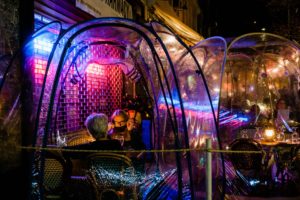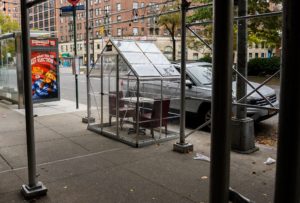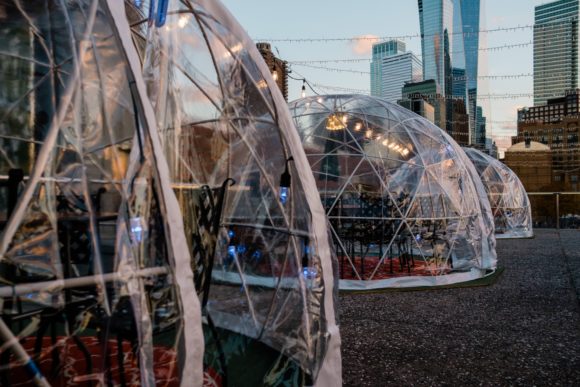As temperatures cool, many of the outside dining options that have sprung up across the U.S. in reaction to pandemic restrictions have become a little less open-air.
The new structures come in varying forms, from clear plastic tents that allow just a few people to eat together to what appear to be full-on cabins inhabiting former parking spaces. Restaurants hope they’ll keep out the winter chill while keeping the virus at bay. That could allow them to serve more diners amid rules that dictate reduced capacity inside.
The problem: “Some of them are clearly not safe,” said Jack Caravanos, a clinical professor at New York University’s School of Global Public Health and an industrial hygienist whose work assesses the safety of indoor and outdoor environments. “It is sort of the Wild West out there with the creation of these structures.”
Linsey Marr, an engineer who studies the airborne transmission of viruses at Virginia Polytechnic Institute, said the reality is that the safety of these spaces lies somewhere between those of full-on outside dining and going back indoors. “You still should follow all the protocols from indoors,” Marr said of the tent spaces. “People should be distanced, I would prefer to see tables 10 feet apart. People should be wearing masks when they’re not eating.”

Think about it as if you’re sitting near someone smoking a cigarette. The more air circulation there is, the less likely you are to be bothered by the smell of a nearby smoker. The more enclosed the space, the more likely it is that smoke will hang in the air. The same is true of the airborne respiratory droplets and particles that can carry the virus.
Marr said she would only risk dining in these more enclosed tent spaces if the conditions were right. “If nobody else was there — or there were very, very few other people there — I might do it,” she said. “And I wouldn’t do it with people outside my household.”
In New York, where sidewalk dining was such a hit the city decided to make it permanent, regulations for tents depend on how enclosed the structures are. Partial tent enclosures, where at least half of the tent’s sidewall surface area is open, are regulated the same as any outdoor dining, the idea being that with so much open space, air can easily circulate through. Fuller tent enclosures, though, face the same capacity limitations as indoor dining, with a state-mandated 25% occupancy maximum.
In those cases, restaurants must also follow stricter procedures for indoor dining, such as checking the temperature of diners. Restaurants must apply for permits for outdoor dining, but no additional permits are required for tents.
One-third to one-half of New York City’s restaurants and bars could shut down within the next six months to a year, according to estimates cited in an October report by New York State Comptroller Thomas DiNapoli.In the meantime, the outside venues have been a needed lifeline for the city’s eateries, the New York mayor’s office said in a statement. More than 10,000 restaurants have participated in the outdoor dining program.
“Of course, New Yorkers should decide what’s right for them before they dine — but we’re confident that current rules strike the right balance between supporting small businesses and fighting back Covid-19,” said Mitch Schwartz, deputy press secretary at the mayor’s office.
But rates are surging across the country, hitting record numbers of more than 130,000 new cases a day. Those rates may grow even more as the weather cools, spurring even more people to gather together indoors. All this raises new questions about these hybrid indoor-outdoor spaces. New York Mayor Bill de Blasio has previously said that the city should halt indoor dining if the seven-day positivity rate surpassed 2%. That threshold has already been crossed, but despite calls to end indoor dining until rates recede, the city has so far moved only to ban it after 10 p.m.

“We’re all hoping that we’ll have a mild winter, with some warm days where people are still comfortable eating outdoors,” said Andrew Rigie, executive director of the NYC Hospitality Alliance, which represents nearly 3,000 restaurants in the five boroughs and has called for increasing indoor dining occupancy, to 50% of capacity from 25%. “But the reality is, New York City winters get really cold. And people are not going to sit outside and dine in the freezing cold and snow.”
In addition to tent setups that can, at times, be elaborate, restaurants have begun adding outdoor heaters and telling diners to “BYOB” — bring your own blanket. Some even give out the type of foil blankets used after a marathon, Rigie said. At least one restaurant has offered blankets for $4 a pop.
While restrictions vary among cities and states on what forms of dining are allowed, many locations have chosen to treat enclosed tents differently than more al fresco options. In Illinois, where indoor dining shut down across the state as levels of the virus surged, outdoor tents have become crucial for restaurants. Chicago requires that at least half of the sides stay open.
Some eateries in Chicago’s Fulton Market district have set up clear, enclosed pods known as igloos on a shut-down street. The pods need to have some ventilation, seat six people or fewer at a table, and be sanitized between parties, said Sam Toia, president and chief executive officer of the Illinois Restaurant Association.
In Connecticut, such pods were briefly off-limits. New guidelines now allow them alongside such measures as adequate ventilation and signs telling customers that enclosed spaces carry higher risks, the Connecticut Restaurant Association said last week.
NYU’s Caravanos said he’s watched with concern the rise of more enclosed outdoor dining spaces, including one being built near his university that “literally looks like a huge outdoor restaurant made of plywood.”
But restaurant patrons can take steps to protect themselves, something he and his wife did at dinner just the other week. At a pub with a semi-enclosed outdoor setup, they eschewed a corner seat for a big table by the entrance, Caravanos said. “It’s all about risk assessment,” he said.
About the photo (top): Social distancing bubble dining tents on the roof deck of a restaurant in New York.
Was this article valuable?
Here are more articles you may enjoy.


 JPMorgan Wins Gender Pay Gap Dispute Against London Analyst
JPMorgan Wins Gender Pay Gap Dispute Against London Analyst  Musk’s xAI Faces California AG Probe Over Grok Sexual Images
Musk’s xAI Faces California AG Probe Over Grok Sexual Images  Allianz Built An AI Agent to Train Claims Professionals in Virtual Reality
Allianz Built An AI Agent to Train Claims Professionals in Virtual Reality  First Brands Judge Approves Examiner to Probe Fraud Allegations
First Brands Judge Approves Examiner to Probe Fraud Allegations 